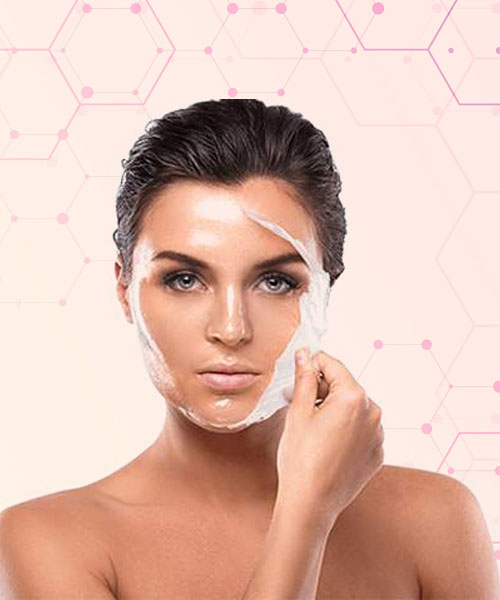
𝐂𝐡𝐞𝐦𝐢𝐜𝐚𝐥 𝐏𝐞𝐞𝐥 𝐓𝐫𝐞𝐚𝐭𝐦𝐞𝐧𝐭𝐬
𝘙𝘦𝘷𝘦𝘢𝘭 𝘙𝘢𝘥𝘪𝘢𝘯𝘵, 𝘙𝘦𝘧𝘳𝘦𝘴𝘩𝘦𝘥 𝘚𝘬𝘪𝘯 𝘸𝘪𝘵𝘩 𝘌𝘹𝘱𝘦𝘳𝘵 𝘌𝘹𝘧𝘰𝘭𝘪𝘢𝘵𝘪𝘰𝘯 𝘢𝘵 𝘋𝘦𝘴𝘪𝘳𝘦 𝘈𝘦𝘴𝘵𝘩𝘦𝘵𝘪𝘤𝘴
Chemical peels are advanced skin treatments designed to improve texture, tone, and clarity by removing dead skin cells using controlled chemical exfoliation. At Desire Aesthetics, we offer a range of medical-grade chemical peels tailored to your skin type and concerns—helping you achieve smoother, brighter, and more youthful-looking skin.
𝐖𝐡𝐚𝐭 𝐈𝐬 𝐚 𝐂𝐡𝐞𝐦𝐢𝐜𝐚𝐥 𝐏𝐞𝐞𝐥?
A chemical peel involves applying a specialized solution to the skin, which gently exfoliates and removes damaged outer layers. The regenerated skin is:
. Smoother and more even-toned
. Less wrinkled and more radiant
. Better able to absorb skincare products
While some peels are available over the counter, professional peels should only be administered by a qualified dermatologist, esthetician, or cosmetic surgeon for safe and effective results.
𝐓𝐲𝐩𝐞𝐬 𝐨𝐟 𝐂𝐡𝐞𝐦𝐢𝐜𝐚𝐥 𝐏𝐞𝐞𝐥𝐬 𝐖𝐞 𝐎𝐟𝐟𝐞𝐫
𝐀𝐥𝐩𝐡𝐚 𝐇𝐲𝐝𝐫𝐨𝐱𝐲 𝐀𝐜𝐢𝐝 (𝐀𝐇𝐀) 𝐏𝐞𝐞𝐥𝐬
. Derived from natural sources like sugarcane, yogurt, and fruits
. Includes glycolic acid, lactic acid, citric acid, malic acid, and tartaric acid
. Ideal for treating fine lines, dry patches, uneven pigmentation, and mild acne
. Gentle exfoliation with minimal downtime
. May cause temporary redness, stinging, or dryness
𝐁𝐞𝐭𝐚 𝐇𝐲𝐝𝐫𝐨𝐱𝐲 𝐀𝐜𝐢𝐝 (𝐁𝐇𝐀) 𝐏𝐞𝐞𝐥𝐬
. Primarily salicylic acid, known for deep pore penetration
. Effective for acne-prone and oily skin
. Controls sebum production and reduces breakouts
. Offers deeper exfoliation than AHAs
. Helps unclog pores and refine skin texture
𝐉𝐞𝐬𝐬𝐧𝐞𝐫’𝐬 𝐏𝐞𝐞𝐥
. A blend of salicylic acid, lactic acid, and resorcinol in ethanol
. Targets pigmentation, acne scars, and uneven skin tone
. Prepares skin for deeper peels like retinoic acid
. Low risk of over-peeling; suitable for layered treatments
𝐑𝐞𝐭𝐢𝐧𝐨𝐢𝐜 𝐀𝐜𝐢𝐝 𝐏𝐞𝐞𝐥
. A deeper peel using vitamin A derivative
. Stimulates collagen production and cell turnover
. Treats wrinkles, scars, and pigmentation issues
. Often combined with Jessner’s Peel for enhanced penetration
. Peeling typically begins on day 3, revealing rejuvenated skin
𝐖𝐡𝐲 𝐂𝐡𝐨𝐨𝐬𝐞 𝐃𝐞𝐬𝐢𝐫𝐞 𝐀𝐞𝐬𝐭𝐡𝐞𝐭𝐢𝐜𝐬 𝐟𝐨𝐫 𝐂𝐡𝐞𝐦𝐢𝐜𝐚𝐥 𝐏𝐞𝐞𝐥𝐬 𝐢𝐧 𝐂𝐡𝐞𝐧𝐧𝐚𝐢?
. Led by Dr. A. Sivakumar, a senior consultant with 20+ years of experience
. Customized peel protocols based on your skin type and goals
. Safe, sterile environment with international standards of care
. Minimal downtime and visible results
. Ethical consultations and post-treatment guidance
𝐑𝐞𝐚𝐝𝐲 𝐭𝐨 𝐫𝐞𝐧𝐞𝐰 𝐲𝐨𝐮𝐫 𝐬𝐤𝐢𝐧 𝐚𝐧𝐝 𝐫𝐞𝐬𝐭𝐨𝐫𝐞 𝐲𝐨𝐮𝐫 𝐠𝐥𝐨𝐰?
Book your consultation today at Desire Aesthetics, Chennai’s trusted destination for chemical peels and advanced skin rejuvenation.

